Fan Xu
NeuralOGCM: Differentiable Ocean Modeling with Learnable Physics
Dec 12, 2025Abstract:High-precision scientific simulation faces a long-standing trade-off between computational efficiency and physical fidelity. To address this challenge, we propose NeuralOGCM, an ocean modeling framework that fuses differentiable programming with deep learning. At the core of NeuralOGCM is a fully differentiable dynamical solver, which leverages physics knowledge as its core inductive bias. The learnable physics integration captures large-scale, deterministic physical evolution, and transforms key physical parameters (e.g., diffusion coefficients) into learnable parameters, enabling the model to autonomously optimize its physical core via end-to-end training. Concurrently, a deep neural network learns to correct for subgrid-scale processes and discretization errors not captured by the physics model. Both components work in synergy, with their outputs integrated by a unified ODE solver. Experiments demonstrate that NeuralOGCM maintains long-term stability and physical consistency, significantly outperforming traditional numerical models in speed and pure AI baselines in accuracy. Our work paves a new path for building fast, stable, and physically-plausible models for scientific computing.
HAD: HAllucination Detection Language Models Based on a Comprehensive Hallucination Taxonomy
Oct 22, 2025Abstract:The increasing reliance on natural language generation (NLG) models, particularly large language models, has raised concerns about the reliability and accuracy of their outputs. A key challenge is hallucination, where models produce plausible but incorrect information. As a result, hallucination detection has become a critical task. In this work, we introduce a comprehensive hallucination taxonomy with 11 categories across various NLG tasks and propose the HAllucination Detection (HAD) models https://github.com/pku0xff/HAD, which integrate hallucination detection, span-level identification, and correction into a single inference process. Trained on an elaborate synthetic dataset of about 90K samples, our HAD models are versatile and can be applied to various NLG tasks. We also carefully annotate a test set for hallucination detection, called HADTest, which contains 2,248 samples. Evaluations on in-domain and out-of-domain test sets show that our HAD models generally outperform the existing baselines, achieving state-of-the-art results on HaluEval, FactCHD, and FaithBench, confirming their robustness and versatility.
JointCQ: Improving Factual Hallucination Detection with Joint Claim and Query Generation
Oct 22, 2025Abstract:Current large language models (LLMs) often suffer from hallucination issues, i,e, generating content that appears factual but is actually unreliable. A typical hallucination detection pipeline involves response decomposition (i.e., claim extraction), query generation, evidence collection (i.e., search or retrieval), and claim verification. However, existing methods exhibit limitations in the first two stages, such as context loss during claim extraction and low specificity in query generation, resulting in degraded performance across the hallucination detection pipeline. In this work, we introduce JointCQ https://github.com/pku0xff/JointCQ, a joint claim-and-query generation framework designed to construct an effective and efficient claim-query generator. Our framework leverages elaborately designed evaluation criteria to filter synthesized training data, and finetunes a language model for joint claim extraction and query generation, providing reliable and informative inputs for downstream search and verification. Experimental results demonstrate that our method outperforms previous methods on multiple open-domain QA hallucination detection benchmarks, advancing the goal of more trustworthy and transparent language model systems.
TopInG: Topologically Interpretable Graph Learning via Persistent Rationale Filtration
Oct 06, 2025Abstract:Graph Neural Networks (GNNs) have shown remarkable success across various scientific fields, yet their adoption in critical decision-making is often hindered by a lack of interpretability. Recently, intrinsically interpretable GNNs have been studied to provide insights into model predictions by identifying rationale substructures in graphs. However, existing methods face challenges when the underlying rationale subgraphs are complex and varied. In this work, we propose TopInG: Topologically Interpretable Graph Learning, a novel topological framework that leverages persistent homology to identify persistent rationale subgraphs. TopInG employs a rationale filtration learning approach to model an autoregressive generation process of rationale subgraphs, and introduces a self-adjusted topological constraint, termed topological discrepancy, to enforce a persistent topological distinction between rationale subgraphs and irrelevant counterparts. We provide theoretical guarantees that our loss function is uniquely optimized by the ground truth under specific conditions. Extensive experiments demonstrate TopInG's effectiveness in tackling key challenges, such as handling variform rationale subgraphs, balancing predictive performance with interpretability, and mitigating spurious correlations. Results show that our approach improves upon state-of-the-art methods on both predictive accuracy and interpretation quality.
PADReg: Physics-Aware Deformable Registration Guided by Contact Force for Ultrasound Sequences
Aug 12, 2025Abstract:Ultrasound deformable registration estimates spatial transformations between pairs of deformed ultrasound images, which is crucial for capturing biomechanical properties and enhancing diagnostic accuracy in diseases such as thyroid nodules and breast cancer. However, ultrasound deformable registration remains highly challenging, especially under large deformation. The inherently low contrast, heavy noise and ambiguous tissue boundaries in ultrasound images severely hinder reliable feature extraction and correspondence matching. Existing methods often suffer from poor anatomical alignment and lack physical interpretability. To address the problem, we propose PADReg, a physics-aware deformable registration framework guided by contact force. PADReg leverages synchronized contact force measured by robotic ultrasound systems as a physical prior to constrain the registration. Specifically, instead of directly predicting deformation fields, we first construct a pixel-wise stiffness map utilizing the multi-modal information from contact force and ultrasound images. The stiffness map is then combined with force data to estimate a dense deformation field, through a lightweight physics-aware module inspired by Hooke's law. This design enables PADReg to achieve physically plausible registration with better anatomical alignment than previous methods relying solely on image similarity. Experiments on in-vivo datasets demonstrate that it attains a HD95 of 12.90, which is 21.34\% better than state-of-the-art methods. The source code is available at https://github.com/evelynskip/PADReg.
Multimodal Representation Alignment for Cross-modal Information Retrieval
Jun 10, 2025Abstract:Different machine learning models can represent the same underlying concept in different ways. This variability is particularly valuable for in-the-wild multimodal retrieval, where the objective is to identify the corresponding representation in one modality given another modality as input. This challenge can be effectively framed as a feature alignment problem. For example, given a sentence encoded by a language model, retrieve the most semantically aligned image based on features produced by an image encoder, or vice versa. In this work, we first investigate the geometric relationships between visual and textual embeddings derived from both vision-language models and combined unimodal models. We then align these representations using four standard similarity metrics as well as two learned ones, implemented via neural networks. Our findings indicate that the Wasserstein distance can serve as an informative measure of the modality gap, while cosine similarity consistently outperforms alternative metrics in feature alignment tasks. Furthermore, we observe that conventional architectures such as multilayer perceptrons are insufficient for capturing the complex interactions between image and text representations. Our study offers novel insights and practical considerations for researchers working in multimodal information retrieval, particularly in real-world, cross-modal applications.
NeuralOM: Neural Ocean Model for Subseasonal-to-Seasonal Simulation
May 27, 2025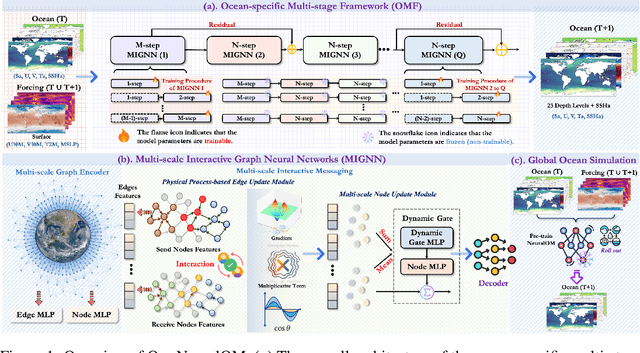

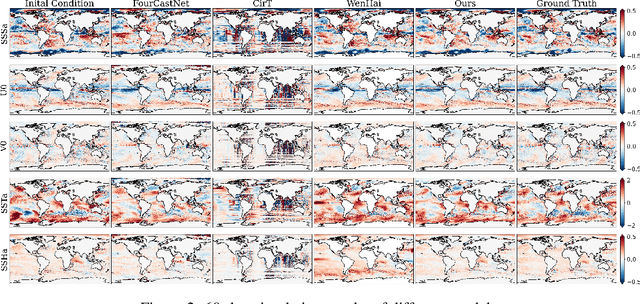
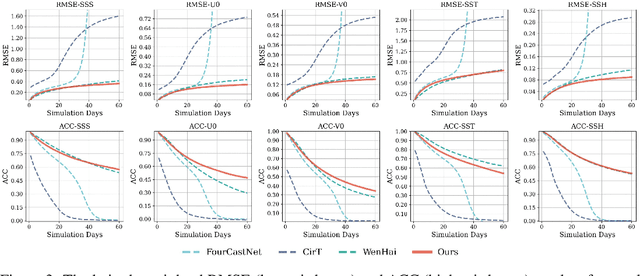
Abstract:Accurate Subseasonal-to-Seasonal (S2S) ocean simulation is critically important for marine research, yet remains challenging due to its substantial thermal inertia and extended time delay. Machine learning (ML)-based models have demonstrated significant advancements in simulation accuracy and computational efficiency compared to traditional numerical methods. Nevertheless, a significant limitation of current ML models for S2S ocean simulation is their inadequate incorporation of physical consistency and the slow-changing properties of the ocean system. In this work, we propose a neural ocean model (NeuralOM) for S2S ocean simulation with a multi-scale interactive graph neural network to emulate diverse physical phenomena associated with ocean systems effectively. Specifically, we propose a multi-stage framework tailored to model the ocean's slowly changing nature. Additionally, we introduce a multi-scale interactive messaging module to capture complex dynamical behaviors, such as gradient changes and multiplicative coupling relationships inherent in ocean dynamics. Extensive experimental evaluations confirm that our proposed NeuralOM outperforms state-of-the-art models in S2S and extreme event simulation. The codes are available at https://github.com/YuanGao-YG/NeuralOM.
Advanced long-term earth system forecasting by learning the small-scale nature
May 26, 2025Abstract:Reliable long-term forecast of Earth system dynamics is heavily hampered by instabilities in current AI models during extended autoregressive simulations. These failures often originate from inherent spectral bias, leading to inadequate representation of critical high-frequency, small-scale processes and subsequent uncontrolled error amplification. We present Triton, an AI framework designed to address this fundamental challenge. Inspired by increasing grids to explicitly resolve small scales in numerical models, Triton employs a hierarchical architecture processing information across multiple resolutions to mitigate spectral bias and explicitly model cross-scale dynamics. We demonstrate Triton's superior performance on challenging forecast tasks, achieving stable year-long global temperature forecasts, skillful Kuroshio eddy predictions till 120 days, and high-fidelity turbulence simulations preserving fine-scale structures all without external forcing, with significantly surpassing baseline AI models in long-term stability and accuracy. By effectively suppressing high-frequency error accumulation, Triton offers a promising pathway towards trustworthy AI-driven simulation for climate and earth system science.
Turb-L1: Achieving Long-term Turbulence Tracing By Tackling Spectral Bias
May 25, 2025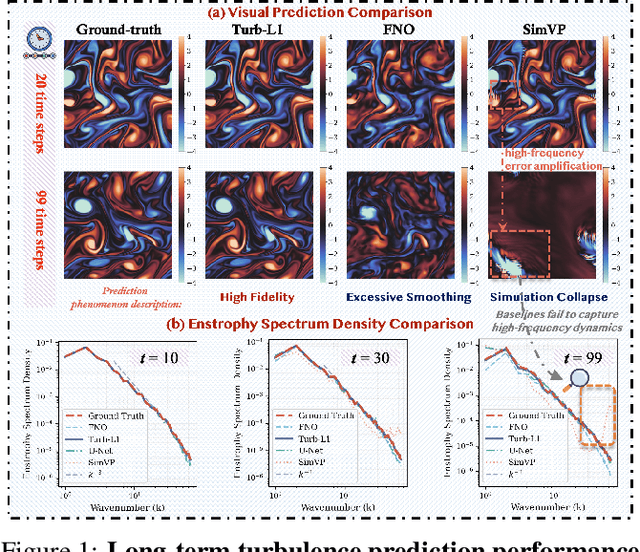
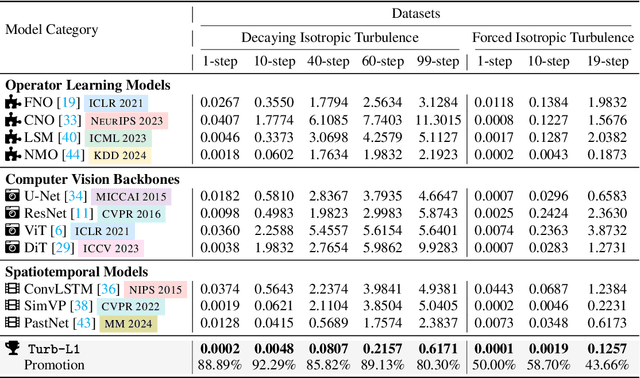
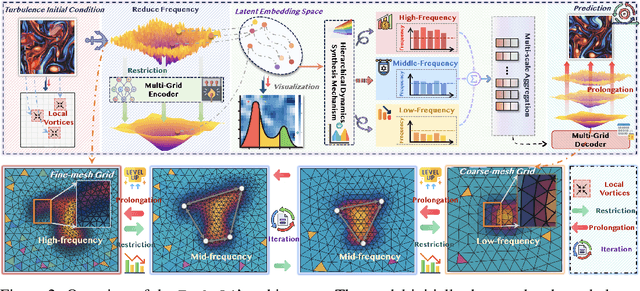
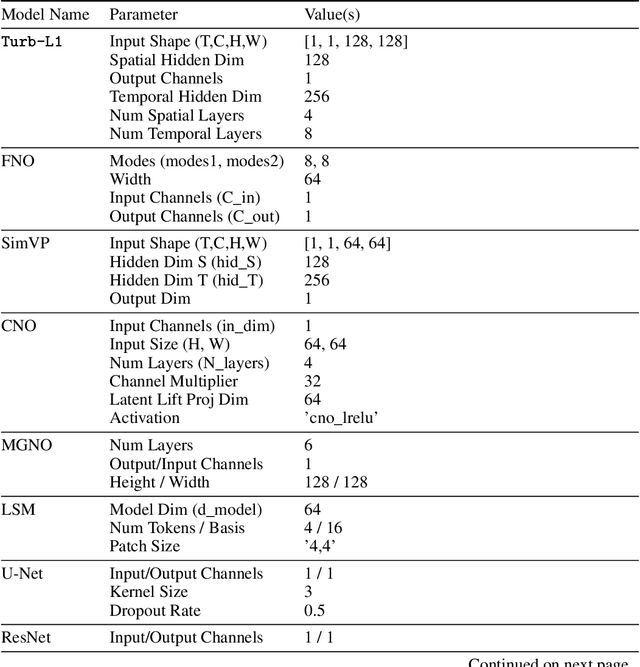
Abstract:Accurately predicting the long-term evolution of turbulence is crucial for advancing scientific understanding and optimizing engineering applications. However, existing deep learning methods face significant bottlenecks in long-term autoregressive prediction, which exhibit excessive smoothing and fail to accurately track complex fluid dynamics. Our extensive experimental and spectral analysis of prevailing methods provides an interpretable explanation for this shortcoming, identifying Spectral Bias as the core obstacle. Concretely, spectral bias is the inherent tendency of models to favor low-frequency, smooth features while overlooking critical high-frequency details during training, thus reducing fidelity and causing physical distortions in long-term predictions. Building on this insight, we propose Turb-L1, an innovative turbulence prediction method, which utilizes a Hierarchical Dynamics Synthesis mechanism within a multi-grid architecture to explicitly overcome spectral bias. It accurately captures cross-scale interactions and preserves the fidelity of high-frequency dynamics, enabling reliable long-term tracking of turbulence evolution. Extensive experiments on the 2D turbulence benchmark show that Turb-L1 demonstrates excellent performance: (I) In long-term predictions, it reduces Mean Squared Error (MSE) by $80.3\%$ and increases Structural Similarity (SSIM) by over $9\times$ compared to the SOTA baseline, significantly improving prediction fidelity. (II) It effectively overcomes spectral bias, accurately reproducing the full enstrophy spectrum and maintaining physical realism in high-wavenumber regions, thus avoiding the spectral distortions or spurious energy accumulation seen in other methods.
On the Learning with Augmented Class via Forests
May 14, 2025Abstract:Decision trees and forests have achieved successes in various real applications, most working with all testing classes known in training data. In this work, we focus on learning with augmented class via forests, where an augmented class may appear in testing data yet not in training data. We incorporate information of augmented class into trees' splitting, i.e., a new splitting criterion, called augmented Gini impurity, is introduced to exploit some unlabeled data from testing distribution. We then develop the approach named Learning with Augmented Class via Forests (LACForest), which constructs shallow forests based on the augmented Gini impurity and then splits forests with pseudo-labeled augmented instances for better performance. We also develop deep neural forests with a novel optimization objective based on our augmented Gini impurity, so as to utilize the representation power of neural networks for forests. Theoretically, we present the convergence analysis for augmented Gini impurity, and finally conduct experiments to verify the effectiveness of our approaches. The code is available at https://github.com/nju-xuf/LACForest/.
 Add to Chrome
Add to Chrome Add to Firefox
Add to Firefox Add to Edge
Add to Edge